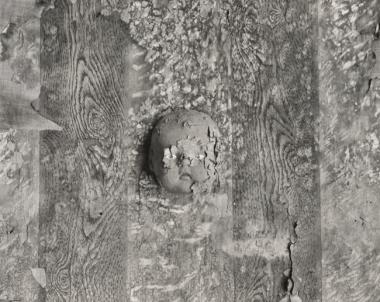Frederick Sommer
Frederick Sommer, Medallion, 1948. Frederick Sommer Archive.
© 1999 Frederick and Frances Sommer Foundation. 76.32.27
Frederick Sommer was an intellectual and artist before he went on to become one of the great photographers of the modern era. Born in Angri, Italy, he grew up in Brazil, where his father designed gardens. In the 1920s, Sommer studied landscape architecture at Cornell University, where he met and soon after married Frances Watson, a graduate student studying education. Upon returning to Brazil, Sommer was diagnosed with tuberculosis and in 1930 he and Frances traveled to Switzerland for treatment. By that time, Sommer was developing a sophisticated appreciation of modern art and was already accomplished in drawing and painting. His photography pursuits would become part of a broader interest in the arts that also included music, writing, found sculpture and collage.
Sommer’s career as a photographer unfolded largely in Arizona. The Sommers moved to Tucson in 1931, and then to Prescott, which would be their home for the rest of their lives. He had his first one-man exhibition of watercolors in 1933, the same year he first saw the work of Edward Weston, which piqued his interest in photography. After visiting Alfred Stieglitz in New York in 1935 and then meeting Edward Weston in California, the young artist fully embraced the creative possibilities of the camera, and he began crafting a body of work unparalleled in the history of the medium for its diverse and experimental qualities. He found the Arizona landscape imbued with a surreal quality that resonated with his unique aesthetic sensibilities: a formal elegance and a cool exactitude coupled with a penchant for emotionally charged—and sometimes even shocking or macabre—subject matter. Sommer’s work also possesses a technical mastery that has contributed to his status as a legendary photographer.
Sommer was not well known throughout his career largely because the popular view of what photography ought to be about and look like centered on the familiar documentary image or the aesthetically pleasing landscape, neither of which interested him. He resisted applying any single label to his numerous photographic experiments and styles, but said his work followed an “imaginative course.” In 1938 he began to compose and photograph still life arrangements -- chicken heads and entrails, and other found objects in nature -- with an 8x10 inch view camera. The addition of a longer focal length lens prompted him to photograph distant landscapes. Sommer’s surprising horizon-less views of the Arizona desert presented new ways of seeing and interpreting the landscape. He made Surrealist images from re-configured doll parts and in 1957 began making abstract camera-less negatives with materials such as paint on cellophane and then smoke on glass. He formed new images by appropriating, deconstructing, and re-configuring other artists’ works and scientific book illustrations long before the term “postmodernism” was coined.
The Center for Creative Photography acquired the Frederick Sommer Archive in 1975 as one of its five founding collections. It includes 88 fine prints, negatives, and his personal papers such as correspondence, manuscripts, and poetry. In addition, correspondence from Sommer is found in the Archives of Aaron Siskind and Edward Weston. The Frederick and Frances Sommer Foundation is located in Prescott, Arizona.


